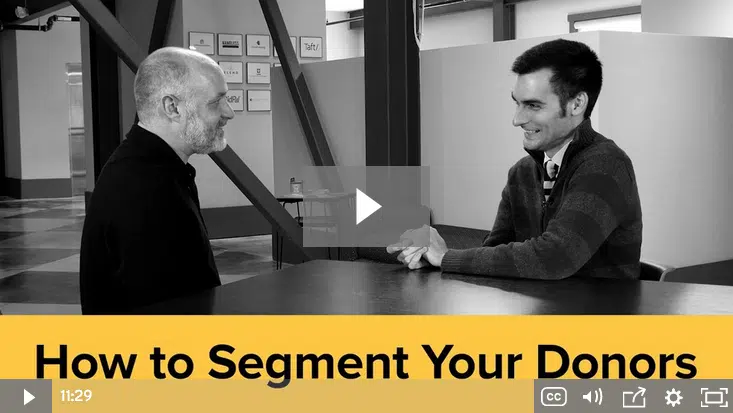How and Why You Should Segment Your Donors

Great storytelling starts with knowing who you are talking to.
So when Christopher Davenport of the Nonprofit Storytelling Conference stopped by our offices to chat about storytelling, my mind immediately turned to data segmenting – naturally!
Why?
Because segmenting your constituents is essential for telling the right stories to the right constituents.
You can watch my full conversation with Christopher below. Hopefully it will inspire you to craft targeted messages to individual audiences!
Full Transcript:
Steven: All right.
Chris: All right.
Steven: Lay it on me.
Chris: All right. Steven?
Steven: Yes. Chris: Let’s talk segmenting because segmenting is something probably people are scared of.
Steven: Yes.
Chris: They might not know the power of segmenting, why you need segmenting, and what exactly is segmenting.
Steven: It sounds scary.
Chris: It does.
Steven: It sounds like a dental procedure.
Chris: Yeah. It does.
Steven: That’s not a good thing. But it shouldn’t be scary. It’s awesome, actually. I think it’s the best way to unlock the true potential of the people you’re communicating to. I think that what a lot of nonprofits tend to do is, we have a bucket of donors. All the people who support us, they’re in one bucket and anytime we want to communicate to them or make news known to them, or ask for help, we send out our one message to that one bucket.
We don’t think about the fact that there are many, many different kinds of people in that bucket who may respond to messaging a certain way or through a certain channel, or most importantly, may respond to a different kind of ask than others. So when we don’t segment our messaging and our communication, we really set ourselves up for failure. I think that’s one of the reasons why perhaps donor retention rates are so low, and especially appeal rates are so low because we basically treat all of our donors like they’re all the same, which is really leaving a lot on the table.
Chris: One of the things I get asked all the time is, “Chris, okay. You’re all about storytelling. So since you know all about storytelling, what stories should I tell people?”
Steven: Yeah.
Chris: I always say, “Well, who are you telling the story to?”
Steven: Yes. That is the right first question.
Chris: So really, when people are talking storytelling and “What stories should I tell?” they need to start with segmenting who their audience is.
Steven: The audience, exactly. Because there’s no other way to craft a compelling story if you don’t know who you’re talking to. It becomes crafting “stories” plural, not just one story. Because you may have one story you want to tell to one kind of donor, and that’s different than a story that you want to tell to another kind of donor, or maybe a non-donor who is in your list.
I mean, that in its most basic form is a good way to start segmenting your donors versus your non-donors. Because you may have people on your email list, for example, who maybe they’ve come to an event or they’ve volunteered, but they have not donated. So what story do we need to tell those non-donors, and what story do we need to tell current donors so that they keep giving?
So that’s an example of a very simple way to approach segmenting. But you can go many, many layers deeper and the more layers further you go, usually the better the results because you’re getting very targeted and tailored communication to a specific type of constituent.
Chris: Yes.
Steven: Easy.
Chris: But let’s step back a little bit.
Steven: Yeah.
Chris: What are the types of things that you can actually segment? I mean, is it just the size of a gift?
Steven: It can be.
Chris: What can you segment?
Steven: We recommend you start off with four basic segments. So at a minimum, you would have these four segments and what it requires you to do is to know, first, your average gift size. So maybe your average donation is $25, or $70, or $114, whatever it is. Find out that gift amount. Then, segment by people who give above that amount and people who give below that amount. Then you can cross-section that by people who have given only once, so they’ve only given one gift to your organization, and then people who have given multiple gifts to your organization.
So you have four segments there. You have people who are repeat donors, above or below your average gift size, and first-time donors above or below your average gift size.
The reason we like first-time donors is, first-time donors, people who’ve only given one gift, they are at the highest risk of lapsing. The FEP report and lots of other reports of, say, donor retention, usually their retention rates are in the 20th percentile. So we’re losing about 8 out of 10 first-time donors. Those donors should be communicated to very specifically so that they give a second time because those reports also show that if you can get a second gift from someone, the retention rates can triple and quadruple even in some cases.
So once you get that second gift, you’re a little bit out of the woods in terms of retention. But for people who have given multiple times, we want them to keep giving, yes. But maybe you want to introduce other things to them, maybe volunteering if they’re not a volunteer already, maybe even being on a committee or board, or introducing a major gift
[inaudible 00:04:47] management pipeline, something like that. So once you start with those four basic segments, you can really unlock a lot of cool things to happen among those. The deeper you drill down, typically the better the results are going to be.
So gift size and frequency are great. They’re a nice starting point. One of my favorites is using donor engagement. So if you have a way to measure how engaged a donor is, and there can be many, many factors that go into that. How often they volunteer. Do they open your emails? Do they have soft credits in your database? Are they telling other people about you? Those are people that you may want to set aside and do something very special for because those are your potential major gift donors. Those are potential bequest donors, perhaps. Those are potential board members, and communicating to those people, those are kind of your superstars.
What happens is, those superstars get lumped into just your generic messaging, and they don’t feel like superstars because you’re treating them like everybody else. So at the very least, isolate those people and make them feel like the awesome unicorns that they are because they really are. I think that’s maybe one reason why things like major gift fundraising and bequest-giving are so difficult, is we don’t set those special people aside and treat them special. We just kind of lump everybody into this one basket and hope someone raises their hand to do something special every once in a while.
Chris: Well, we’re also overworked, though. I mean, that just sounds like so much extra work to do.
Steven: Well, think of it this way. It may cost you more not to do it. Because if you don’t do these things, your donors are going to lapse and you’re stuck on this acquisition treadmill, which it’s a never-ending workload to refill your bucket of donors every year because people are leaking out the bottom of it. Once you get off that acquisition treadmill, you’ll find that you have lots of time for these things. You don’t have to worry about acquisition events and direct mail sends that you hope someone will just respond to. I think the other thing is, you’ll find that it’s much more fun.
Stewardship and donor retention, and donor engagement, these things are way more fun than having a golf outing or teeing up an event that everybody in the organization hates, but we do it every year because that’s what we do. That’s one of the reasons why we put a real focus on donor engagement and the Bloomerang product because we wanted for smaller nonprofits, medium-sized nonprofits to be able to measure how engaged their donors are. Before Bloomerang, there was really no way to do that unless you were willing to create a crazy Excel formula, which nobody has time to do that. So that’s one of the reasons we built Bloomerang the way we did, is so that we could bring this power to nonprofits that haven’t had it historically.
A lot of it is simple reporting, and many of the CRMs that are available today do this. You can run simple LYBUNT and SYBUNT reports. You can run reports on your monthly donors. That’s a great segment, people who have decided to give monthly. That’s an awesome segment to do something special for. People who have only given once, and maybe they haven’t given in a couple of years, maybe we want to do something special for those people. So it really comes down to not just sending one newsletter to everybody, not just sending one appeal to everybody. Even in the acknowledgement process, not just having your one thank you letter that all of your donors get.
It’s really making multiple versions of all these things that speak to one specific audience, and most importantly try to get them to do one specific thing that you know we want that segment to do and the action that we think that segment is going to more or likely to do, because that’s what it really comes down to. If you ask a major gift donor to contribute $7 on Giving Tuesday, that may tick them off. That may annoy them, anger them, but most importantly you’re missing out on a big opportunity to make a more appropriate ask to that donor based on their recency of giving and gift size, and all that good stuff.
Chris: So it’s really about communicating or telling a story to the right donor at the right time with the right story or communication message.
Steven: Exactly. Right. It’s hard to crack that story until you know who you’re talking to. Any good writer who has sat down to write a story or a novel, they kind of know who their audience is or the kind of person that they want to communicate these things to. Think of your daily interactions. Chris, you and I interact in a way that is different than how my boss and I interact, that’s different than how my spouse and I interact, that’s different than how a casual acquaintance and I act. But nonprofit communications doesn’t model that. It’s sort of odd. We just send the one thing to everyone on our list and hope something sticks, and then we are confused when it doesn’t stick. So let’s stop doing that. We should segment our donors and our constituents.
Chris: One of the things I’m excited about is the Nonprofit Storytelling Conference, and the fact that you, Bloomerang, is a presenting sponsor. This is an absolute wonderful opportunity for people to come up to you and talk to you about segmenting or anything else around, “How do you craft those initial stories? How do you find out about the donors?”
Steven: Please do. Please come see us because we geek out about this stuff. It was a no-brainer for us to be the presenting sponsor of this Nonprofit Storytelling Conference because you guys get it, all of the sessions you put together are awesome, it’s all of our favorite people, and it’s totally aligned. The reason we’re there is not to really sell software. We do that anyway. We want to hang out with you guys, and we want to help solve problems. Our software is just one of the ways that we help the nonprofit sector. It’s not meant to be the only way. The Storytelling Conference is just an extension of that.
So come to us with your problems. We’re former fundraisers ourselves. We understand the issues you’re going through. Bring your thank you letters. Bring your reports. Come to us with all your segmenting problems because we love to help and hopefully we can give you some practical advice that you can take away, even if you’re not yet a Bloomerang user.








Comments